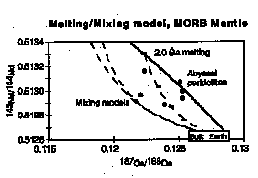
Os isotopes have great potential as tracers of mantle processes, thanks to the very different geochemical behaviors of parent and daughter isotopes compared with other isotopic systems. At the same time, this is also the greatest problem with the Re-Os isotopic system: relating isotopic variations to processes that are better understood.
We can model the expected evolution of the combined Re-Os, Sm-Nd and Rb-Sr isotopic systems in melting residues using reasonable guesses for the bulk partitioning of these elements. We quickly arrive at Sr-Nd melting and mantle evolution models that reasonably account for the observed Sr-Nd isotopic systematics in MORB and abyssal peridotites. The Re-Os isotopic system should behave
similarly to the Rb-Sr isotopic system, in that Re is more incompatible than Os, just as Rb is more incompatible than Sr. The very tight correlation of Os and Nd isotopes predicted by any reasonable silicate-only melting model is not observable in the oceanic mantle data set, even when alteration effects are accounted for (Fig. 1; Snow et al., 1994; Snow and Reisberg, 1995).
This result seems to imply that silicate melting alone cannot account for the combined Os-Nd systematics
in abyssal peridotites. A likely candidate hypothesis for generating decoupled Nd-Os isotopic variations is strong partitioning of Re and Os into sulfide phases in the mantle. Some sulfide is probably always retained in modern mantle sources, since mantle PGE concentrations are rarely below about .01 x Chondrites. Evidence that this was not always the case comes from ancient komatiites, which have much lower Re/Os ratios and higher PGE's overall than modern basalts (Walker et al., 1988). This suggests that komatiites were not saturated with sulfide during melting, and that the degree of melting changes the Re/Os bulk partitioning by varying the amount of retained sulfide in the residue.
Modelling depleted mantle formation with residual sulfide yields plausible concentrations for S, Re and Os in the residual mantle and primitive liquids such as picrites and komatiites. The D(sulfide/melt), D(sulfide/silicate) and D(silicate/melt) required to do so are all within the range of experimentally determined values. While such melting cannot account for all the Nd-Os isotopic variations seen in the oceanic mantle, back-mixing of the depleted material with primitive mantle can potentially account for the observed decoupling.
Snow, J., Hart, S.R. & Dick, H., Nature 371, 57-60 (1994).
Snow, J. & Reisberg, L., Earth, Plan. Sci. Lett. 133, 411-421 (1995).
Walker, R., Shirey, S. & Stecher, O., Earth, Plan. Sci. Lett. 87, 1-12 (1988).
Fig. 1.